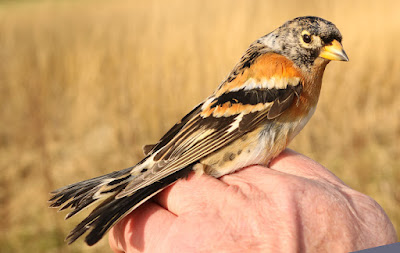Months had passed since my last Barn Owl; maybe I’m not getting out enough or hitting the wrong spots? The lack of sightings was rectified on Friday by an encounter out Stalmine way as I drove across the elevated moss road towards Out Rawcliffe and a farm I know.
There was some noise and activity from small birds, Tree Sparrows and Chaffinches, and a Blackbird alarm call as a Sparrowhawk shot through the jumble of buildings and out the other side. It’s impossible not to admire how Sparrowhawks hunt by the element of surprise, taking small birds in an instant with their gangling legs and razor sharp talons. During the catching and ringing of a Sparrowhawk it’s essential to know how quickly the hawk can pierce fingers.
Although the weather has been mainly wet and cold we’ve had very few frosts so it’s good to see the sheep bang on cue with their first lambs, the one below just a day or two old.
I drove towards Pilling and Cockerham to mainly check out the set-aside ringing station that’s out of action for ringing purposes but not for additional feeding. There are still lots of birds and even an increase in the usual pack of Linnets today with three separate flocks totalling in excess of 450, a record count for this winter. I scattered another bucketful of seed in the net rides and left the birds to pick the winners.
There has been snow in the hills not far away and also in Scotland, both of which provide numbers of our wintering Linnets here on the relatively warmer Gulf-streamed coast. If only we could have ringed a more Linnets in the last two months; for sure many will be back to Scotland very soon.
I noted the usual Kestrel, 20 or more Chaffinches, Greenfinches and also a couple of fence hopping Meadow Pipits. Meadow Pipits have been absent of late but this too is a species subject to moving south and west during colder weather. In just three to four weeks the longer distance migrants will pass through as they head back to the uplands and their breeding areas.
I stopped to chat to a couple of wildfowlers, the chaps incredulous that our ringing is still not allowed while their own pastime is unaffected by the same 10km control zone. One told of an hour or more before seeing on the marsh a Shelduck in distress that he could have reached but did not want to handle for fear of Avian Flu. Neither would he be allowed to put the duck out of its possible misery. He'd also seen a Marsh Harrier, possibly two, out on Pilling Marsh.
I have no problem with wildfowlers and their pastime. Wildfowling is an ancient feature of the countryside, one that arose long before the relatively modern sports of bird watching or twitching. Almost without exception I find wildfowlers are knowledgeable about birds simply because many are involved in active habitat conservation and improvement.
As regular readers will know from this blog and other reading, there is a real distinction between “wildfowlers” and “shooters”. My opposition to the rearing of millions of wildfowl and game birds for driven shoots and its effect on the countryside features here on a regular basis; some might say too often!
I drove up to Cockerham and a pootle around the lanes where the well scattered winter swans remain the major attraction pending springtime. Twelve Bewick’s Swans, over 300 Whooper Swans and uncounted Mutes are still impressive even though after spending four months in the same fields they keep a distance from birders in cars and birders out of cars.
I stopped at Gulf Lane and the other seed plot - another 80+ Linnets. Blimey!
And I am still waiting for a reply to the request for an exemption to local restrictions so as to catch and ring a Red-listed, declining species of farmland bird.
N

























